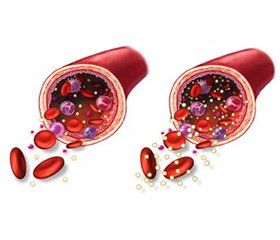Журнал «Здоровье ребенка» 3 (63) 2015
Вернуться к номеру
Screening of blood plasma cholesterol level in children from families with diabetes mellitus
Авторы: L. Prystupiuk — Bogomolets National Medical University, Kyiv, Ukraine
Рубрики: Педиатрия/Неонатология
Разделы: Клинические исследования
Версия для печати
INTRODUCTION.
Today, diabetes mellitus (DM) is threatening disease with the constant increase in the number of patients. According to statistics of the Ministry of Health of Ukraine at the end of 2013, there are 1,380,047 patients with a DM, prevalence 3041.6 per 100,000 of population. Of this amount 1,280,561 patients suffering from type 2 DM. That is, up to 3.3% of the ukrainian population suffer from T2DM. According to the results of epidemiological studies, the actual number of patients with DM2 in our country, as in most other countries, higher than the official statistics. Number of diabetic patients will doubled by 2035, is projected to increase in the number of patients with DM by 23% in the European region and 110% in the African sub-Saharan countries region.
The purpose of the study.
To screen and study the prevalence of hypercholesterolemia in young children of families of patients with diabetes mellitus.
Materials and methods.
Examined were children aged 4-10 years in families of patients with type 1 and type 2 DM, 5% of whom suffering from obesity. The presence of obesity was diagnosed using centile tables of height and body weight for boys and girls aged from 2 to 18 years. Cholesterol level was determined in fasting plasma venous blood. The analysis was performed on automated analyzers by enzymatic colorimetric method (Cobas 6000 (c 501 module) enzymatic-colorimetric method, using a test system Roche Diagnostics (Switzerland). According to cholesterol level, the group of examined children was divided into the following categories: normal level – up to 4.4 mmol/L, risk level – 4.41-5.2 mmol/L and high level – over 5.2 mmol/L.
Results.
The study involved 110 children, 48 boys and 62 girls. In 40% of boys cholesterolemia was within acceptable values of between 2.67 mmol/L and 4.38 mmol/L (average 3.70 ± 0,04 mmol/L). 42% of the examined boys had risk levels of cholesterol between 4.41 mmol/L and 5.15 mmol/L (average 4.79 ± 0.01 mmol/L). And 18% of these boys were to have high plasma cholesterol levels between 5.22 mmol/L and 6.11 mmol/L (average 5.50 ± 0.01 mmol/L). Corresponding indicators for girls were 68% for normal levels, 21% for risk levels, and 11% for high levels. If we analyze the content of cholesterol level in relation to gender, we find out that the indicators were better in girls than in boys, because the normal cholesterol levels were higher while the abnormal levels were lower. According to the guidelines of the National Education Program of the US on Diabetes Mellitus, maximum efforts must be undertaken at the very threatening stages of diabetes. Revealed signs of hypercholesterolemia in children from families of patients with diabetes of both types require effective efforts to normalize cholesterol levels in such children. First of all, it’s both proper diet and physical activity for children, prevention of overweight and obesity, annual control of cholesterol in the blood plasma.
Conclusions.
1. The study of cholesterol level in the blood plasma of children aged 4-10 years from families burdened concerning hereditarily diabetes found that 40% of boys indicators cholesterol level were within normal level, in 42% - risk level, and 18% in cholesterol plasma was high level. Similar figures for girls were equal to 68%, 21% and 11%.
2. Active detection for hypercholesterolemia will help create proper diet and physical activity programs for children in order to correct any disorders of their lipid metabolism.
3. Timely correction of dyslipidemia in children could be considered as a guarantee for the prevention of diabetes and cardiovascular disorders.

